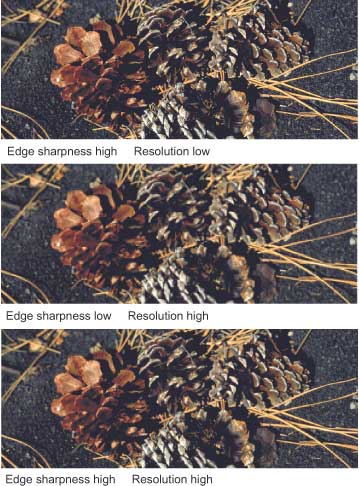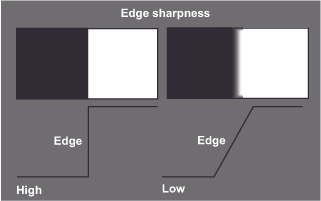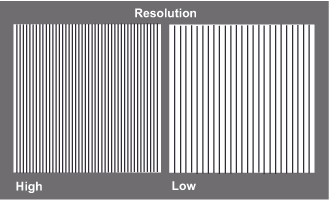We can measure the brightness of a light stimulus in cd/m2 and determine its chromaticity by its wavelength structure, but sharpness is a purely perceived property of a visual scene that we cannot determine directly. It is only in the eye of the beholder. Generally, we characterize a visual impression as sharp when we can clearly distinguish the objects from each other. Therefore, unlike taste or smell, visual sharpness is a perceptual measure that assesses the clarity or distinctness of object edges. Detecting these edges is of great interest to the visual system because, as the chapter about Image creation, Depth and Size (Second step – beginning of information processing) has shown, it organizes object perception around them: the objects in a scene are not just detected but are individually constructed on the basis of their perceived edges. This process is elaborate, and its exact sequence is still controversial among scientists.
Without the registration of the object boundaries, no visual perception could arise. The following experiment practically simulates the truth of this statement. Imagine, for example, a red square in the middle of which there is a smaller green square. If you artificially stabilize the border between the two areas on your retina, you will first lose the perception of the green square, and only the red area of the background will remain. After about a second without any movement relative to the retina, this impression also dissolves, and you see nothing. This is the case because the photoreceptors only report potential differences to us, not absolute potential levels, which also serves to increase efficiency. To ensure that we do not lose perception when our gaze lingers on one point for a long time, the eyes perform unconscious movements that are random in direction several times per second, so-called microsaccades.
The answer to why our visual system structures and distinguishes objects based on the interfaces between areas of different color and brightness is simple: economy, effectiveness, and low energy consumption.
It makes a lot of sense, as it is cost-effective, for the visual system to process objects based on interruptions in light patterns. This method allows it to encode only the parts of the image that undergo changes, rather than the entire image. Edges and borders are the only important information that the apparatus in our heads needs to construct the shapes and forms of things in our environment. It is unnecessary to define brightness and color at every single point of, for example, a solid red object. Instead, it is sufficient to define brightness and color at every point where something changes. And this is the case at an edge or boundary. This approach significantly reduces the amount of information required for transmission and processing.
We can see exactly how much by comparing two graphics in .tif or .jpeg format. Let’s assume that the image shows a red circle in the middle of a green area in 10×15 cm format. In .tif there are 1715 KB. In .jpeg only 13 KB – 132x less. The reduction is due to the fact that .jpeg, just like the visual system, only defines those pixels where something changes. The file only contains the border position and color on the inside or outside. The image processing program automatically fills in the pixels in between.
Visual acuity is a byproduct of the visual system’s process of achieving object perception.
In order to capture as many edges as accurately as possible, the eye and brain must rasterize the field of view in as much detail as possible and then isolate the borders. This is quite an ambitious task, and our visual system accomplishes it in several stages. For precise scanning, it uses a large number of photoreceptors. Their distance from each other, along with a few other factors we will learn about below, determines the resolving power of the visual apparatus.
To reliably isolate the object edges in the resulting image, the visual system has the remarkable ability to process the nerve impulses from the exposure of the photoreceptors, or its visual data, like a computer. It employs a specific type of ganglion cells, physiologically split into the center and periphery, for this purpose. They connect in a way that mutually inhibits each other. We refer to this cell structure as the center/surround organization, which filters out irregularities such as object boundaries. The harder the contour, the more immediate its transition, the greater the output potential of such a center/surround cell and our resulting perception of the contour’s sharpness.
We have now identified the two concepts, resolving power/resolution and contour sharpness, that causally contribute to our perception of sharpness. We will delve deeper into these concepts in the following sections.



Next
Main Visual acuity
If you found this post useful and want to support the continuation of my writing without intrusive advertising, please consider supporting. Your assistance goes towards helping make the content on this website even better. If you’d like to make a one-time ‘tip’ and buy me a coffee, I have a Ko-Fi page. Your support means a lot. Thank you!


 Since I started my first website in the year 2000, I’ve written and published ten books in the German language about photographing the amazing natural wonders of the American West, the details of our visual perception and its photography-related counterparts, and tried to shed some light on the immaterial concepts of quantum and chaos. Now all this material becomes freely accessible on this dedicated English website. I hope many of you find answers and inspiration there. My books are on
Since I started my first website in the year 2000, I’ve written and published ten books in the German language about photographing the amazing natural wonders of the American West, the details of our visual perception and its photography-related counterparts, and tried to shed some light on the immaterial concepts of quantum and chaos. Now all this material becomes freely accessible on this dedicated English website. I hope many of you find answers and inspiration there. My books are on